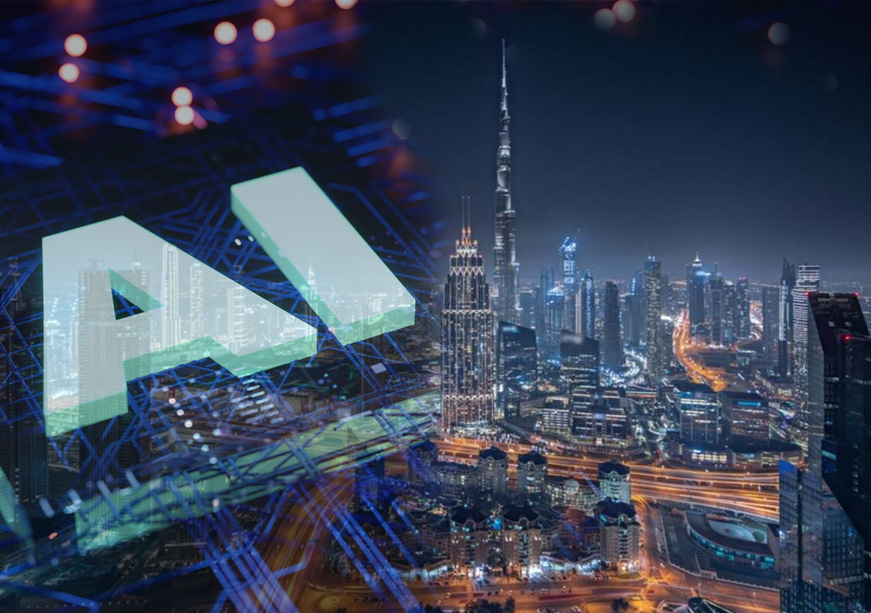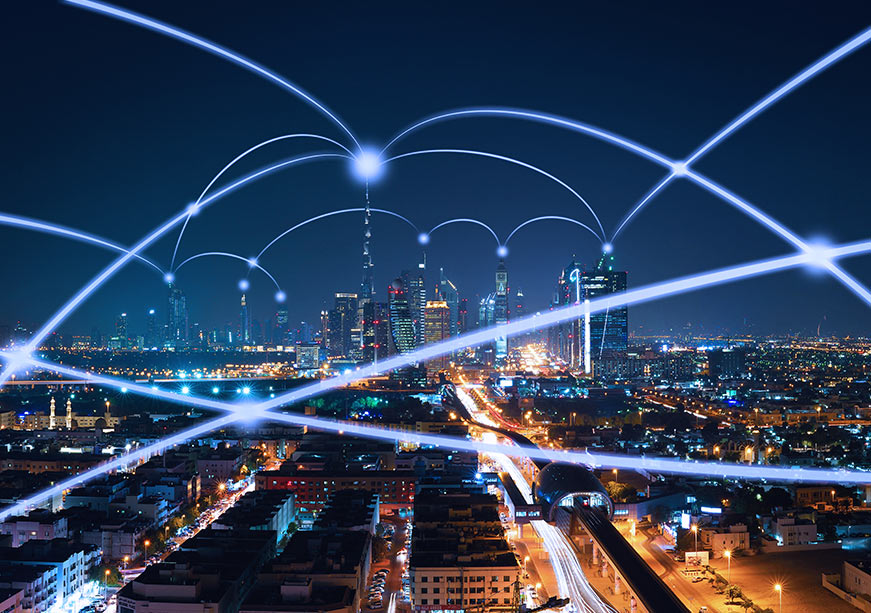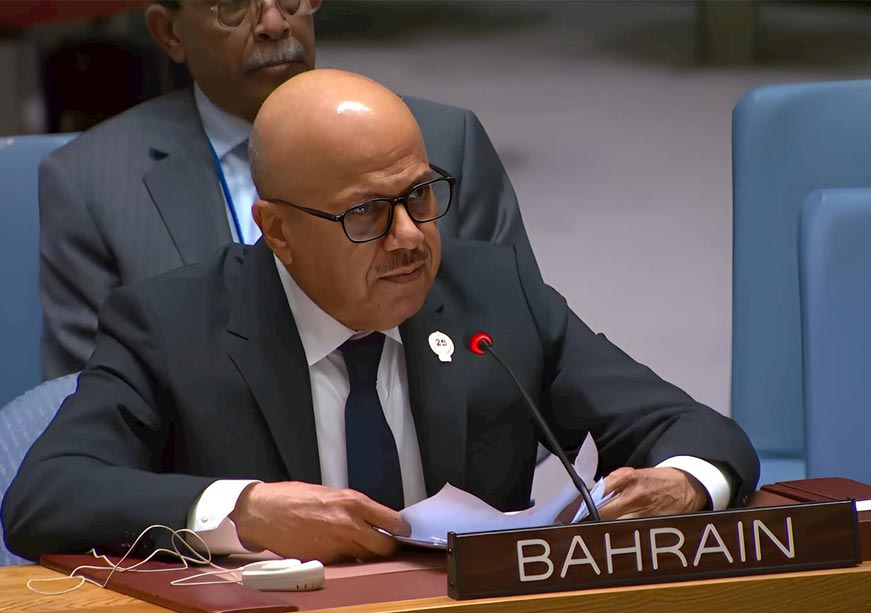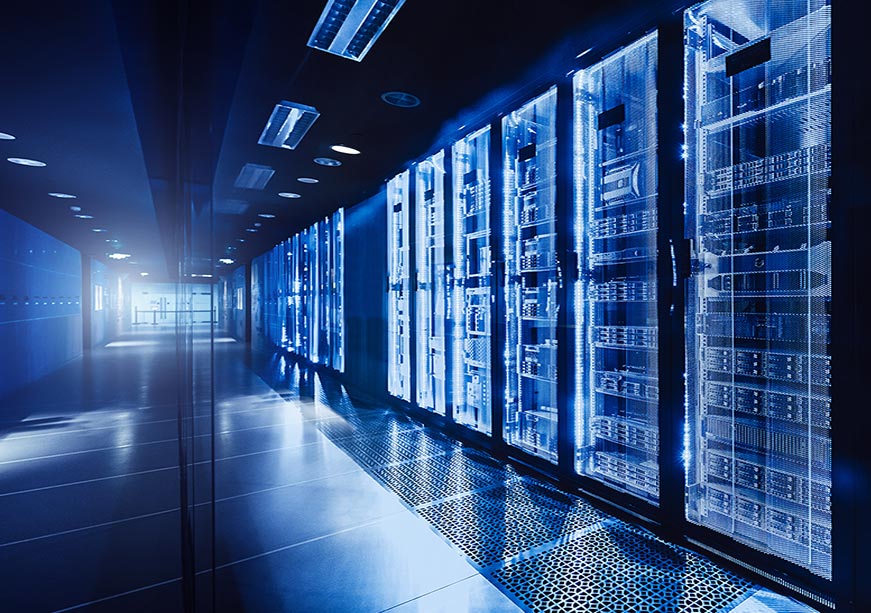From oil to algorithms, the UAE is betting big on energy, capital, and geography to anchor itself as the Middle East’s AI infrastructure powerhouse.
Introduction
Artificial Intelligence (AI) is becoming the horizontal enabling layer of an entire new ecosystem, which means it can be embedded anywhere. While labelled as “AI” today, tomorrow it will simply be an invisible layer that powers the new intelligence revolution. Within this quotient, the United Arab Emirates (UAE) is expected to play a critical role in developing the region’s AI ecosystem, both in terms of energy and infrastructure. This will power the global AI ecosystem, help shape its strategic map, which consists of several key layers, including energy, infrastructure, models, and applications that will serve the entire ecosystem. This will play out within a new, fragmented, and globalised world order, with a redefined Geopolitics of AI. Indeed, the global order has been shifting around a set of strategic alliances in the past few decades, where the UAE will become a critical player. The UAE is emerging as a critical geopolitical player in the global AI race, leveraging a unique combination of energy resources, sovereign capital, and strategic positioning to become an indispensable partner for the United States (US) in the development of AI infrastructure.
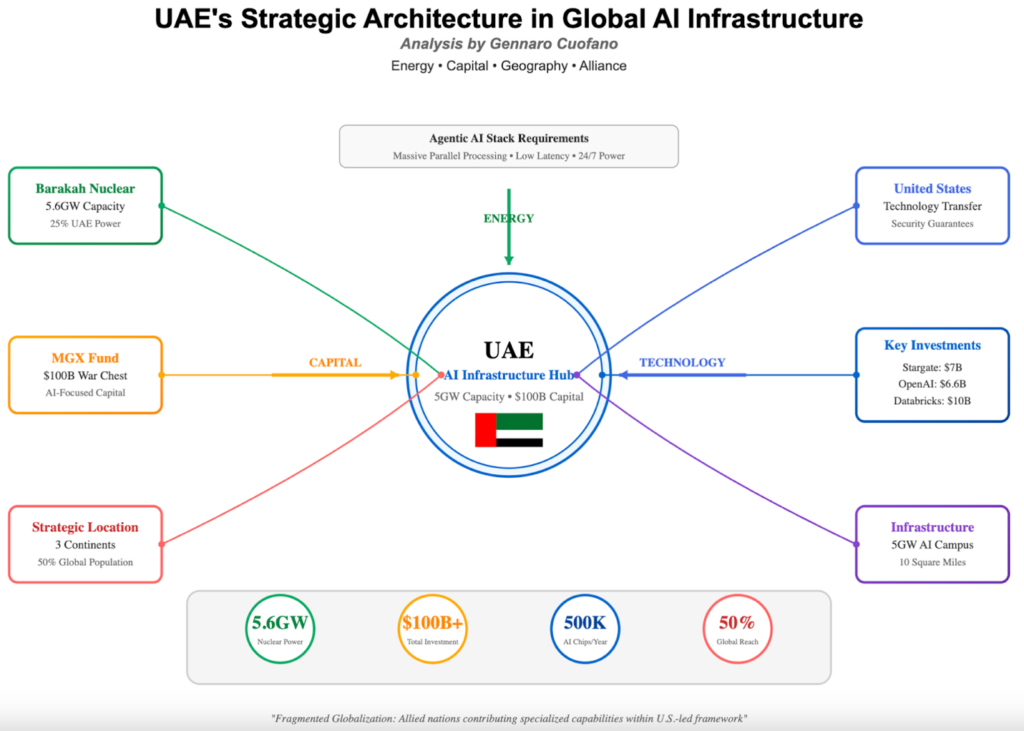
The Infrastructure Advantage: Energy as the Foundation
The UAE’s strategic importance in the AI race rests fundamentally on its unparalleled energy infrastructure capabilities:
Nuclear Power Leadership: The Barakah nuclear power plant, with its 5.6GW capacity now fully operational across four APR-1400 reactors, provides 25 percent of the UAE’s electricity needs. This positions the UAE as the only Arab country in the Middle East bloc with an operational nuclear capacity, offering stable, carbon-free baseload power, which is essential for AI data centres.
The 5GW AI Campus: The newly announced US-UAE AI data centre campus plans to deploy 5GW of capacity, with 1GW in the first phase, utilising nuclear, solar, and gas power, as reported by Data Centre Dynamics. This massive facility, covering 10 square miles in Abu Dhabi, represents one of the largest AI infrastructure projects globally and will serve as “a regional platform from which US hyperscalers will be able to offer latency-friendly services to nearly half of the global population,” as reported by Data Centre Dynamics.
Financial Architecture: MGX as the Strategic Vehicle
The UAE’s financial commitment through MGX demonstrates unprecedented scale in AI infrastructure development. MGX’s strategic investments are channelled meticulously/cautiously to build the physical and technological foundation for AI deployment at a global scale. The fund contributed approximately US$7 billion to the Stargate Project, as reported by Crunchbase, directly funding the construction of massive data centres and computing clusters essential for next-generation AI models. This investment extends beyond capital injection—it is architecting the physical infrastructure that will house millions of Graphics Processing Units (GPUs) and provide the gigawatt-scale power systems required for AI training and inference.
MGX’s participation in OpenAI’s US$6.6 billion funding round, the largest venture capital deal ever as reported by the Arabian Gulf Business Insight (AGBI), specifically targets infrastructure expansion to support ChatGPT’s scaling to 500 million users while building the computational capacity for artificial general intelligence (AGI) development. Similarly, their involvement in Databricks’ US$10 billion raise and xAI’s US$6 billion funding round, as reported by Crunchbase, directly funds the development of specialised AI infrastructure—from Databricks’ data processing pipelines that prepare massive datasets for AI training, to xAI’s Colossus supercomputer facility housing hundreds of thousands of GPUs. These investments create the critical infrastructure layer that transforms raw compute into accessible AI services.
The strategic importance of MGX’s infrastructure focus becomes even clearer through its partnership with BlackRock, GIP, and Microsoft in the AI Infrastructure Partnership, which seeks to unlock an initial US$30 billion in capital to mobilise up to US$100 billion in total investment potential, as reported by the UAE Embassy. This partnership aims to target the development of data centres, energy infrastructure, and the physical networks that will power AI globally—not just funding software development, but building the concrete, steel, and silicon foundation upon which the entire AI economy will operate. Through these coordinated investments, MGX is essentially financing the construction of the AI era’s equivalent of highways, ports, and power grids—fundamental infrastructure that will determine which nations can effectively participate in the AI-driven economy.
The Agentic AI Stack and Infrastructure Requirements
As discussed in previous analyses about the agentic web architecture, the shift to autonomous AI agents creates exponential demands that fundamentally reshape infrastructure requirements. The agent layer requires massive parallel processing capabilities to handle millions of simultaneous agent interactions—imagine countless AI agents negotiating, transacting, and coordinating in real-time, each requiring dedicated computational resources that far exceed those of traditional web services. This computational intensity directly translates into networking demands, where inter-agent communication protocols require regional data centres capable of sub-millisecond response times, as even minor latency can cascade into failed negotiations or broken agent workflows. Perhaps most critically, agent-to-agent transactions and their continuous operation demand uninterrupted power supply—unlike human users who sleep, these agents operate 24/7, making any power interruption potentially catastrophic for the economic transactions they manage.
The agent layer requires massive parallel processing capabilities to handle millions of simultaneous agent interactions—imagine countless AI agents negotiating, transacting, and coordinating in real-time, each requiring dedicated computational resources that far exceed those of traditional web services.
The UAE’s infrastructure directly addresses these interconnected requirements through a unique convergence of capabilities. Its nuclear baseload power from the Barakah plant provides the stable, uninterrupted energy that agent systems require. On the other hand, its strategic geographic positioning between Europe, Asia, and Africa enables the low-latency regional coverage essential for agent-to-agent communications across three continents. This physical infrastructure is supported by sovereign wealth that can commit to decades-long infrastructure development cycles—a timeline that matches the long-term evolution of agentic systems. Where traditional data centres were built for human-initiated queries and batch processing, the UAE is constructing infrastructure specifically designed for the always-on, massively parallel, latency-sensitive world of autonomous AI agents, positioning itself as the backbone for the emerging agent economy.
Geopolitical Realignment: The New AI Alliance Architecture
Building on an analysis of the three-layer framework (geopolitical, economic, and business layers), the UAE exemplifies the US strategy of ‘allied expansion’ versus China’s ‘vertical integration’:
Strategic Alignment: The UAE-US partnership represents what officials call a ‘new golden era’ of cooperation, as reported by MEED, extending an 80-year alliance into the AI domain. This creates a critical node in the US bloc’s network-centric approach to AI dominance.
Technology Transfer Controls: The agreement states “strong security guarantees to prevent diversion of US technology,” with American companies operating the data centres and offering American-managed cloud services throughout the region, as reported by Data Centre Dynamics.
Capital Recirculation: The UAE’s investments through MGX create bidirectional flows—Gulf capital financing US AI development, while US technology and expertise flow back to establish Middle Eastern AI infrastructure.
The UAE’s Strategic Positioning in Global AI Infrastructure
The UAE’s investments in AI infrastructure are creating mutually beneficial partnerships that strengthen its position as a global technology hub:
- Energy Leadership: The UAE leverages its advanced clean energy capabilities, including the Barakah Nuclear Energy Plant and ambitious renewable energy projects, to offer AI companies reliable, gigawatt-scale power solutions. This positions the UAE as a crucial partner for energy-intensive AI operations while advancing its own sustainability goals.
- Strategic Capital Deployment: Through sovereign wealth funds such as MGX and strategic partnerships with major AI companies, the UAE is not just providing capital but actively participating in shaping the future of AI infrastructure. These investments, including discussions with companies like OpenAI as reported by MENA Bytes, demonstrate the UAE’s commitment to being a key stakeholder rather than merely a funding source.
- Geographic Advantage: The UAE’s strategic location creates a natural bridge between East and West, enabling AI companies to serve high-growth markets across Asia, Africa, and the Middle East with low latency. This geographic positioning enhances the UAE’s value proposition as a hub for global AI infrastructure while supporting regional digital transformation initiatives.
- Regulatory Agility: The UAE’s streamlined regulatory framework and government support enable rapid infrastructure deployment, making it an attractive partner for AI companies seeking to scale quickly. This efficiency, combined with the UAE’s Vision 2071 and AI Strategy 2031, creates a conducive environment for long-term technology partnerships and innovation.
The Agentic Future: Infrastructure as Competitive Advantage
As the transition to the agentic web era occurs, control over AI computing infrastructure is becoming the defining factor for platform dominance. The UAE’s unique combination of abundant clean energy from nuclear and renewable sources, substantial sovereign wealth funds that allow for patient capital investment, strategic geographic positioning that connects global markets, political stability with strong international alliances, and proven capabilities for rapid execution positions the nation as a cornerstone in the development of global AI infrastructure.
This convergence of advantages enables the UAE to forge essential partnerships with leading AI companies while establishing itself as a critical hub in the emerging agentic economy, where proximity to powerful computing resources and reliable energy infrastructure will determine which platforms can deliver the low-latency, always-on AI services that define the next generation of digital experiences.
The New Geopolitics of AI
The UAE’s emergence as a key hub for AI infrastructure represents a significant shift in global power dynamics. No longer merely an energy exporter, the UAE has transformed itself into a crucial node in the AI value chain, leveraging its traditional strengths (energy and capital) to secure a central position in the future technology ecosystem.
For the US, the partnership with the UAE and broader Gulf states solves critical infrastructure constraints while extending American AI standards and platforms globally. This ‘fragmented globalisation’ model, where aligned nations contribute specialised capabilities within a US-led framework, may prove more resilient than China’s vertical integration approach.
The success of this strategy will ultimately depend on maintaining technological superiority, ensuring security of critical infrastructure, and managing the complex geopolitical relationships inherent in such deep interdependence. As the AI race intensifies and agentic systems require ever more sophisticated infrastructure, the UAE’s role as the Middle East’s AI infrastructure powerhouse will only grow more strategically vital.
Gennaro Cuofano is an entrepreneur, researcher, and GTM executive who bridges technology, business modelling, and market analysis to deliver unique insights.

